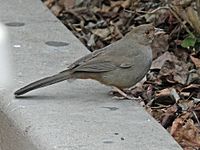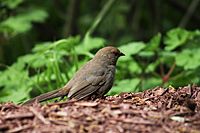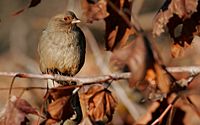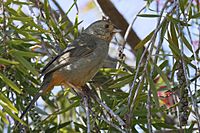California towhee facts for kids
Quick facts for kids California towhee |
|
|---|---|
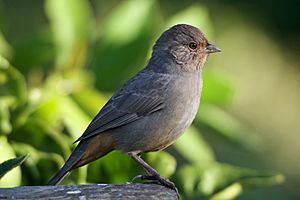 |
|
| In California, USA | |
| Conservation status | |
| Scientific classification | |
| Genus: |
Melozone
|
| Species: |
crissalis
|
 |
|
| Synonyms | |
|
Pipilo crissalis |
|
The California towhee (Melozone crissalis) is a bird that lives in western North America. You can find it along the coast of Oregon and California in the United States. It also lives in Baja California Sur in Mexico. This bird belongs to the family Passerellidae, which includes sparrows and buntings.
Contents
About the California Towhee
Scientists study how different animals are related. For a long time, they discussed if the California towhee was a separate species from the similar canyon towhee. These two bird groups live in different areas. Modern molecular genetics (studying DNA) shows they are indeed two distinct species.
What Does a California Towhee Look Like?
The California towhee is mostly a dull brown color. It has light reddish-brown feathers under its tail. Its throat might have buff or rust-colored streaks. Males and females look very similar. This means there is little sexual dimorphism (difference in appearance between sexes).
It is about 20 to 25 centimeters (8 to 10 inches) long. It also has a noticeably long tail. The tail can be from 8.2 to 11.6 centimeters (3.2 to 4.6 inches) long. It looks like a large, plain sparrow. Males usually weigh around 54 grams (1.9 ounces). Females weigh about 52 grams (1.8 ounces).
Where Do California Towhees Live?
This bird's natural home is in brushy areas or chaparral. Chaparral is a type of shrubland found in California. However, it also lives well in city parks and gardens. Even though it visits bird feeders, it can be hard to spot. This is because it tends to hide in bushes.
California towhees build their nests in low branches or shrubs. Nests are usually about 0.5 to 4 meters (1.6 to 13 feet) above the ground. The nest is a bulky cup. It is made from twigs, stems, grasses, and animal hair.
How Do California Towhees Behave?
The California towhee mostly eats on the ground or in low bushes. It prefers a variety of seeds. It also eats some insects. You will most often see these birds traveling alone or in pairs.
Their call is a single-note sound. People describe it as seet, tsip, cheet, cheenk, or peenk. The bird's song is a long, repeating series of notes. It usually ends with a trill.
The female bird sits on the nest alone. She incubates 2 to 4 eggs for about 11 days. Eggs are laid from March through September. They are pale bluish-white with brownish spots. These spots are usually on the larger end of the egg. Young birds leave the nest after only 8 days.
Gallery
See also
 In Spanish: Rascador californiano para niños
In Spanish: Rascador californiano para niños



